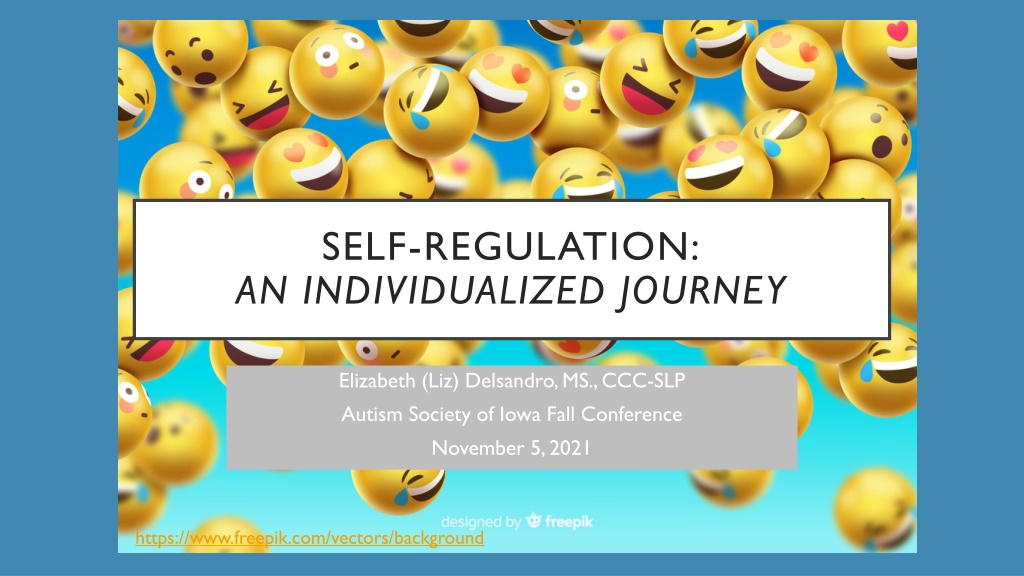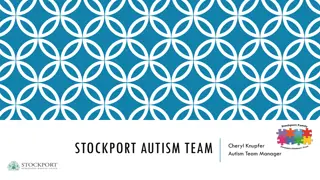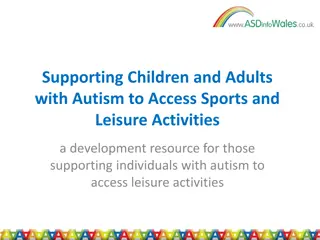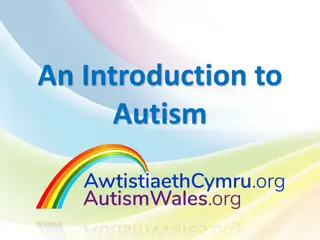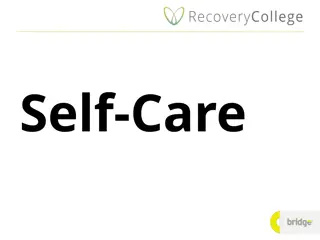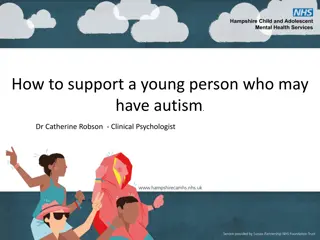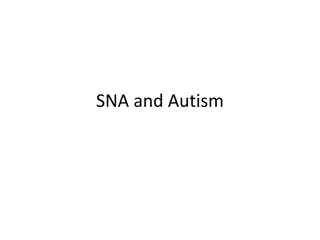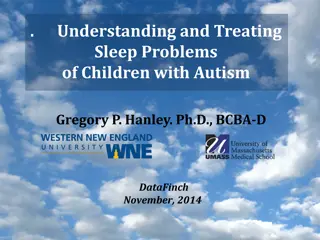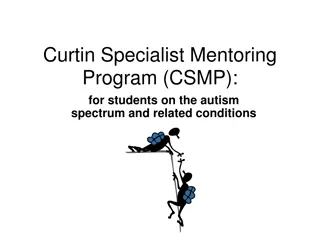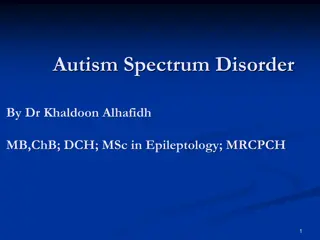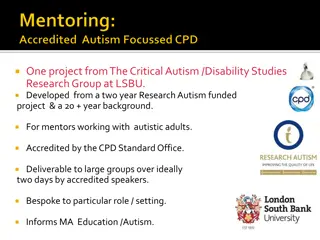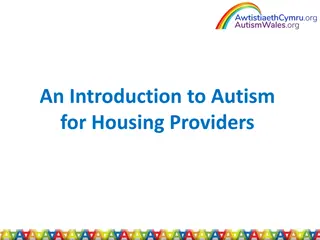Understanding Self-Regulation and Emotional Well-being in Autism
Exploring the complexities of self-regulation in individuals with Autism Spectrum Disorders, this presentation by Elizabeth Delsandro delves into strategies, trauma-informed care, collaboration, and environmental considerations. Addressing common challenges like anxiety and uncertainty intolerance, the talk sheds light on emotional regulation and underlying factors impacting individuals with ASD. Trauma exposure in this population and the importance of recognizing dysregulation beyond surface behaviors are highlighted, emphasizing a holistic approach to support emotional well-being.
Download Presentation

Please find below an Image/Link to download the presentation.
The content on the website is provided AS IS for your information and personal use only. It may not be sold, licensed, or shared on other websites without obtaining consent from the author. Download presentation by click this link. If you encounter any issues during the download, it is possible that the publisher has removed the file from their server.
E N D
Presentation Transcript
SELF-REGULATION: AN INDIVIDUALIZED JOURNEY Elizabeth (Liz) Delsandro, MS., CCC-SLP Autism Society of Iowa Fall Conference November 5, 2021 https://www.freepik.com/vectors/background
OBJECTIVES To explore strategies for self-regulation. To consider tenets of trauma-informed care when working on self-regulation. To recognize the importance of collaboration /teaming when developing an individualized plan for self-regulation. To identify environmental considerations/structure that can promote regulation of emotions
ANXIETY Anxiety is identified as the most commonly reported disorder among individuals with Autism Spectrum Disorders (Hollocks, Lehr, Magiati, Meiser,-Stedman, & Brugha 2018; Rodgers & Ofield, 2018) Researchers suggest that up to 70% of adults with autism spectrum disorders are diagnosed with anxiety disorders (Lugo- Marin, 2019).
UNCERTAINTY INTOLERANCE In a study conducted by Saiz-Suanes et al (2020), anxiety correlated with variables of emotional dysregulation and uncertainty intolerance. They also shared that adults with autism and intellectual disability showed greater of maladaptive emotional regulation strategies and uncertainty intolerance.
EMOTIONAL REGULATION When people try to manage and understand emotions and adapt their emotional response to the context or situation, it is referred to as emotional regulation (Gross, 2015).
BENEATH THE SURFACE Dysregulation in a Individual Limited or restless sleep Constipation Unmet needs Allergies/reactions Eating/feeding differences Negative emotions Significant transition/changes Limited quality relationships Sensory differences Communication differences
BENEATH THE SURFACE Trauma Research indicates that youth living with intellectual and developmental disability (IDD) experience exposure to trauma at a higher rate than their non-disabled peers. -The National Child Traumatic Stress Network
FLIGHT-FIGHT-FREEZE Please note that this is not a complete list of behaviors. Additionally, these are examples of what you may see in an individual without neurodevelopmental disabilities. Flight Fight Freeze Withdrawing Fleeing the situation/room Daydreaming Seeming to sleep Avoiding others Hiding or wandering Becoming disengaged Acting out Behaving aggressively Acting silly Exhibiting distance Being hyperactive Arguing Screaming/yelling Exhibiting numbness Refusing to answer Refusing to get needs met Feeling unable to move or act (Souers & Hall, 2016)
BENEATH THE SURFACE Regulation in a Individual Well rested Nutritional needs met Met needs Digestive health in check Allergies managed Medications managed Safe people and safe spaces Sensory experiences balanced Established and familiar routines Positive emotions Developing way to communicate
HIGHLIGHTING SOME OF MASLOW S HIERARCHY OF NEEDS Self-actualization The desire to become the most that one can be Esteem Self-esteem, respect, recognition, freedom Love and Belonging Family and sense of connection Safety Needs Health and wellness Physiological Needs Shelter, food, sleep
QUESTIONS TO ASK RELATED TO MASLOW S HEIRARCHY OF NEEDS Is the individual getting sleep? Is the individual eating well? Is the individual healthy? Is the individual feeling supported by the people around him/her/them? Does the individual have a safe space to process his/her/their emotions? Are there supports/strategies in place? Does the individual have an opportunity make choices? Does the individual have a mean to communicate his/her/their emotions in an adaptive manner? Questions for caregivers and program personnel to discuss Questions for program personnel to consider
COMMUNICATION IS KEY! Communication Notebook or 2-Minute Check-in: What you check-in about (e.g., sleep, overall health, change) is really dependent on the individual. What you find out may direct you to DIAL IT UP or DIAL IT DOWN. MAX MIN
COMMUNICATION WITH CAREGIVERS If a individual has known behavior challenges, collaborate with the individual s parents/caregivers: Parents/caregivers are experts in their child. Find out what strategies work to promote the individual s adaptive behavior. Parents/caregivers are often quite knowledgeable in what is motivating or reinforcing to the individual. Parents/caregivers can keep you updated on what is happening in the lives of the individual.
BE ENCOURAGING AND SUPPORTIVE Individuals, regardless of their level of functioning, recognize if you enjoy them. Take time to establish rapport with the individual. This is an ongoing process. Relationship matters. Observe and listen to the individual. Respond to your individual. Use a positive tone of voice. Provide verbal praise and encouragement.
LINGUISTIC LEVEL Communicate with the individual as the his/her/their linguistic level. Use vocabulary that is appropriate for the individual s chronological age and developmental functioning. If the individual is visibly frustrated, reduce the amount of language you are using with the individual: Less talking = less frustration Incorporate more pauses. Processing language can be challenging when an individual is frustrated.
UNCERTAINTY INTOLERANCE Buhr and Dugas (2009) defined uncertainty intolerance as a dispositional characteristic that results from a set of negative beliefs about uncertainty and its implications and involves the tendency to react negatively on an emotional, cognitive, and behavioral level to uncertain situations and events.
PRESENT CLEAR EXPECTATIONS Clear expectations can reduce potential anxiety. Establish some routines. Provide a visual schedule. A schedule answers a variety of questions: What will I be doing? What s next? When do I get to do _____? When will I be finished?
PRESENT CLEAR EXPECTATIONS Ensure that instructions are considerate of a individual s linguistic level: Level of vocabulary Length of instructions (e.g., 1-part instructions, 2-part instructions) Provide models of expected behavior or what the individual should be doing before asking the client to carry out the behavior or task. Model Role-play what the expected behavior looks like. Video model of what the expected behavior looks like.
INTERSPERSE EASIER TASKS INTO THE SESSION Embed opportunities for the individual to be successful by incorporating some easier tasks. Consider the order of the easy tasks and challenging tasks for the individual.
INTERSPERSE MOTIVATING ACTIVITIES INTO THE DAY Always be aware of what activities/objects/topics motivate the individual. Always be in the know with what reinforces the individual (keep informed by asking the individual, connecting with parents/caregivers). Strategically place motivating activities into the day. Integrate motivating topics/activities into the day. Alternate motivating activities with less motivating activities in individual schedule. Consider first-then language (e.g., First, _________. Then, we can ________. )
CONSIDER SENSORY NEEDS OF THE INDIVIDUAL Some individuals need to move to regulate themselves in order to attend and participate in planned therapy activities. Plan movement into activities. Change physical positions (e.g., work at the table, on the floor, at the board). Consider movement breaks (e.g., mini dance party). Consult with an occupational therapist if possible about building in sensory activities or creating a sensory diet.
AGAIN: RELATIONSHIP MATTERS! Helpful hints for establishing relationships: Be open, positive, flexible, and understanding. Establish positive routines. Routines can be comforting. Provide the just right level of support, so the individual can be successful in activities. Recognize the individual s strengths and incorporate opportunities in the individual s day to showcase his/her/their strengths. Recognize the individual s interests and motivators, and incorporate opportunities for the individual to engage in their interests within the day. Become knowledgeable of what triggers emotions such as discomfort, fear/anxiety, sadness, and anger in the individual. And, avoid these triggers if possible. Create a safe space for an individual to experience his/her/their emotions.
THE FAILURE TO IMAGINE HOW THE WORLD IS EXPERIENCED BY AUTISTIC PEOPLE CREATES A FAULTY ATTRIBUTION OF INAPPROPRIATE EMOTIONALITY. -BERVOETS ET AL (2021)
INTEROCEPTIVE AWARENESS Emotion regulation involves a coherent relationship with the self, specifically effective communication between body, mind, and feelings. Effective emotion regulation involves the ability to accurately detect and evaluate cues related to physiological reactions to stressful events, accompanied by appropriate regulation strategies that temper and influence the emotional response. There is compelling evidence demonstrating links between poor or disrupted awareness of sensory information, or interoceptive awareness, and difficulties with emotion regulation. (Price & Hooven, 2018)
SYSTEMS FOR EMOTIONAL REGULATION The Incredible 5-Point Scale https://www.5pointscale.com/ The Zones of Regulation https://zonesofregulation.com/index.html Interoception: The Eighth Sensory System https://www.kelly-mahler.com/
ADOPTING A SYSTEM Examples: The Zones of Regulation Leah Kruypers The Incredible 5-Point Scale Kari Dunn Buron & Mitzi Curtis
ADOPTING A SYSTEM Interoception: The Eighth Sensory System Kelly Mahler, MS, OTR/L
REFERENCES Bervoets, J., Milton, D., & Van de Cruys, S (2021). Autism and intolerance of uncertainty: an ill-fitting pair. Trend in Cognitive Sciences. In press. Buhr, K. & Dugas, M. J. (2009). The role of fear of anxiety and intolerance of uncertainty: An experimental manipulation. Behaviour Research and Therapy, 47, 215-223. Gross, J. (2015). The extended process model of emotion regulation: Elaborations, applications, and future directions. Psychological Inquiry, 26, 130- 137. Hollocks, M., J., Lehr, J.W., Magiati, Meiser,-Stedman, I., & Brugha, T. S. (2018). Anxiety and depression in adults with autism: A systematic review and meta- analysis. Psychological Medicine, 1-14.
REFERENCES Lugo-Marin, J., Magan-Maganto, M., River-Santana, A., Cuellar-Pompa, L., Alviani, M., Jenaro-Rio, C. et al (2019). Prevalence of psychiatric disorders in adults with autism spectrum disorder: A systematic review and meta-analysis. Research in Autism Spectrum Disorders., 59, 22-33. Price, C.J. & Hooven, C. (2018). Interoceptive awareness skills for emotion regulation: Theory and approach of mindful awareness in body-oriented therapy (MABT). Frontiers in Psychology, 9, 1-12. Saez-Suanes, G.P., , Garcia-Villamisar, , D., del Pozo Armentia, Araceli, & Dattilo, J. (2020). Emotional dysregulation and uncertainty intolerance as transdiagnostic mediators of anxiety in adults with autism spectrum disorders and intellectual disability, Research in Developmental Disabilities,106, 1-11. Souers, K. & Hall, P. (2016). Fostering resilient learner: Strategies for creating trauma-sensitive classroom. Alexandria, VA: ASCD. Rodgers, J. & Ofield, A. (2018). Understanding, recognizing and treating co- occurring anxiety in autism. Current Developmental Disorders Reports, 5, 58-64.
